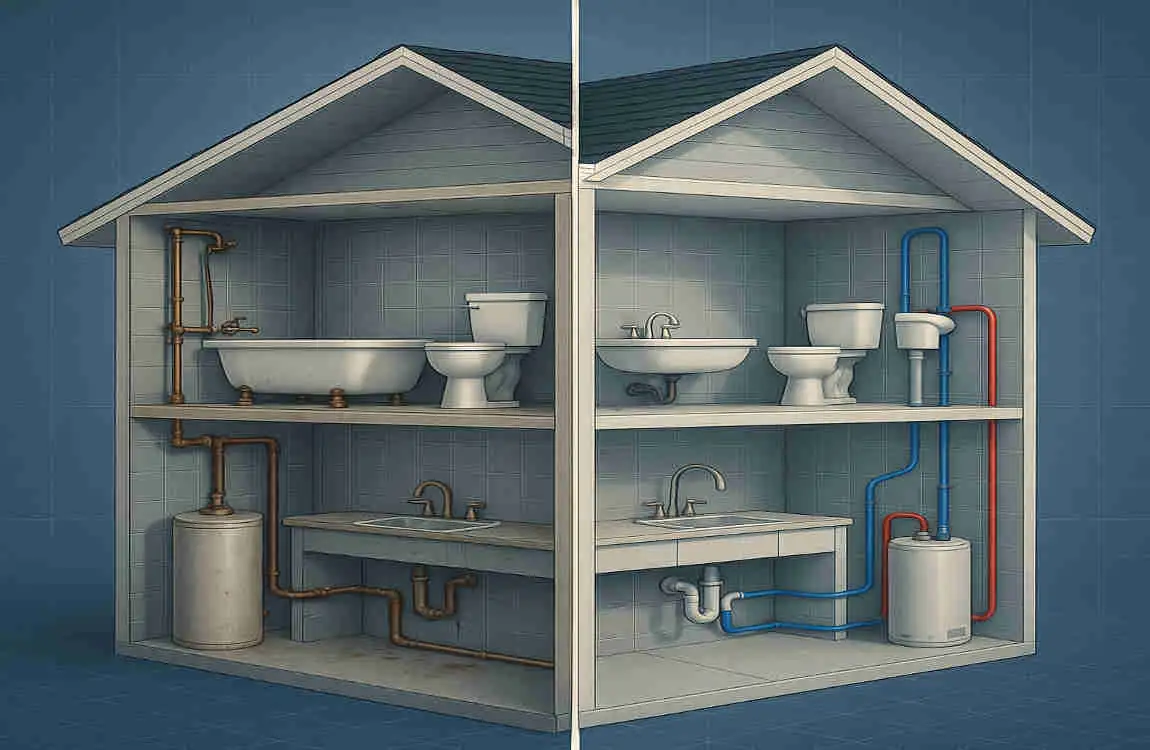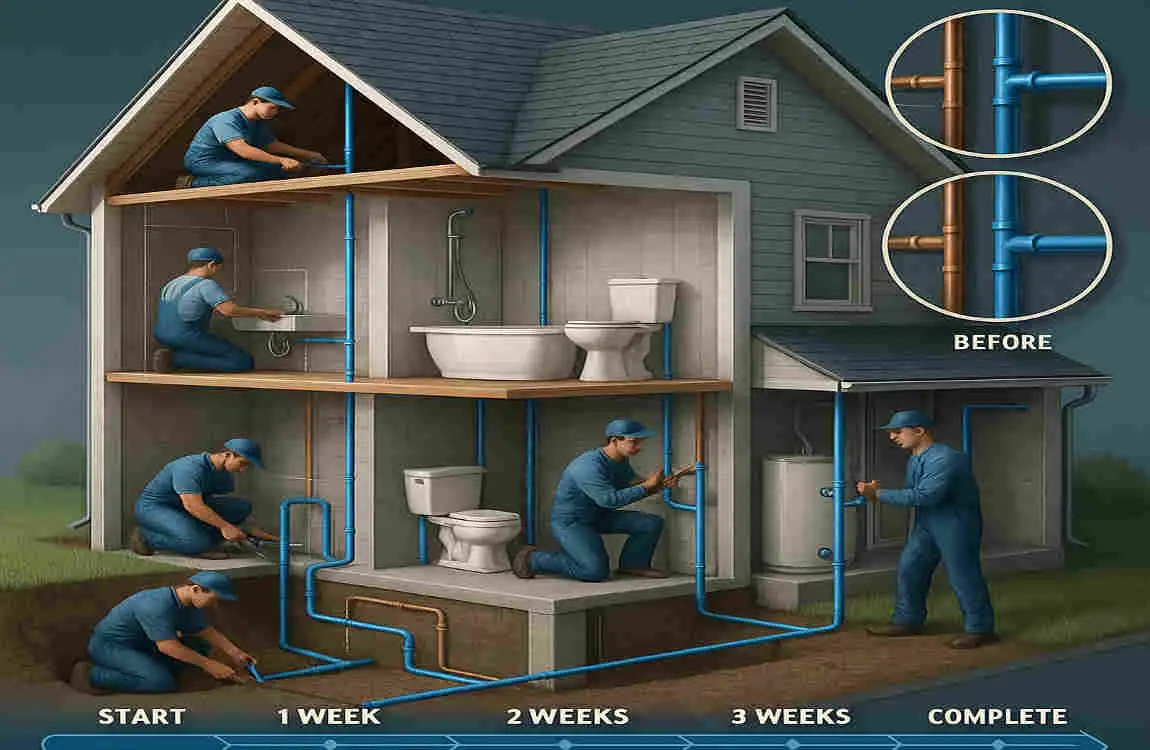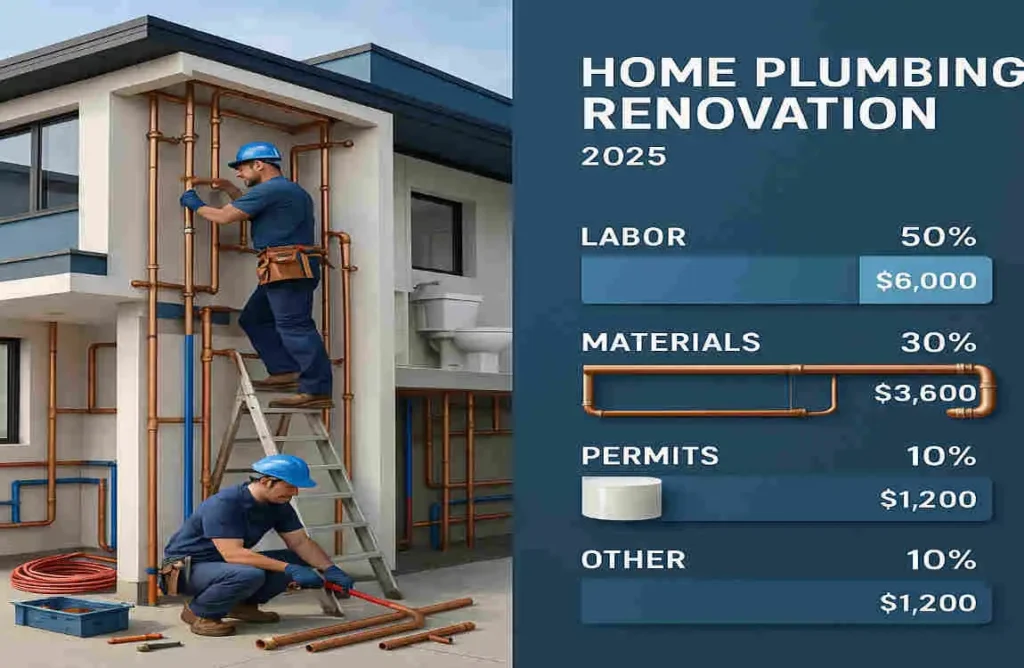Are you a homeowner considering replumbing your house in 2025? You’re not alone. Many homeowners are looking to update their plumbing systems to improve efficiency, safety, and value. But one of the biggest questions on everyone’s mind is: how much does it cost to re-plumb a house?
What Does Replumbing a House Mean?

Before we dive into the costs and process, let’s start with the basics: what does it mean to replumb a house?
Definition and Explanation of Replumbing
Replumbing a house involves replacing the entire plumbing system, including all pipes, fixtures, and appliances. This is different from simple plumbing repairs, which only address specific issues or leaks. Replumbing is a more comprehensive approach that aims to update and improve the entire system.
Difference Between Replumbing and Plumbing Repairs
While plumbing repairs can fix immediate problems, they don’t address the underlying issues with an aging or inefficient plumbing system. Replumbing, on the other hand, provides a long-term solution by replacing all the pipes and components with new, modern materials.
Signs Your House Needs Replumbing
How do you know if your house needs replumbing? Here are some common signs to look out for:
- Low water pressure
- Frequent leaks or bursts
- Discolored or rusty water
- Old or corroded pipes
- High water bills
If you’re experiencing any of these issues, consider replumbing your house.
Factors Affecting How Much to Replumb a House
Now that we understand what replumbing entails, let’s look at the factors that affect the project’s cost.
Size and Age of the House
The size and age of your house are two of the most significant factors that impact the cost of replumbing. Larger homes require more materials and labor, while older homes may have more complex plumbing systems that need updating.
Type of Plumbing Materials Used
The type of plumbing materials you choose can also affect the cost. Common materials include:
- PEX (cross-linked polyethylene)
- Copper
- CPVC (chlorinated polyvinyl chloride)
Each material has its own pros and cons, and the cost can vary depending on the material you choose.
Complexity of the Plumbing System
The complexity of your plumbing system can also impact the cost. Homes with multiple bathrooms, kitchens, or laundry rooms may require more extensive replumbing, which can increase the overall cost.
Accessibility of Plumbing Pipes
The accessibility of your plumbing pipes can also affect the cost. If your pipes are hidden behind walls or in crawl spaces, accessing them may be more difficult and time-consuming, which can increase the project’s cost.
Local Labor and Material Costs in 2025
Labor and material costs can vary by location. In 2025, these costs may be higher or lower depending on economic factors and supply and demand.
Additional Costs
Finally, there may be additional costs associated with replumbing, such as permits, inspections, and demolition. These costs can add up, so it’s important to factor them into your budget.
Average Cost to Replumb a House in 2025
Now that we’ve covered the factors that affect replumbing costs, let’s look at the average costs you can expect in 2025.
National Average Price Range Breakdown
According to industry experts, the national average cost to replumb a house in 2025 is expected to range from $5,000 to $15,000. This range can vary depending on factors we discussed earlier, such as the size and age of your home, the materials you choose, and your location.
Cost Estimates by House Size
Here are some cost estimates based on the size of your home:
- Small homes (under 1,500 square feet): $3,000 to $7,000
- Medium homes (1,500 to 2,500 square feet): $5,000 to $10,000
- Large homes (over 2,500 square feet): $8,000 to $15,000
Keep in mind that these are just estimates, and your actual cost may vary.
Material Cost Comparison
The material you choose can also affect the cost. Here’s a comparison of the average costs for different materials:
Material Average Cost per Linear Foot
PEX $0.50 to $1.00
Copper $2.00 to $4.00
CPVC $0.75 to $1.50
As you can see, PEX is generally the most affordable option, while copper is the most expensive.
Cost Examples from Different Regions or States
The cost of replumbing can also vary depending on your location. Here are some examples of average costs in different regions or states:
- Northeast: $6,000 to $12,000
- South: $5,000 to $10,000
- Midwest: $4,000 to $9,000
- West: $7,000 to $15,000
These are just examples, and your actual cost may vary depending on your specific location and other factors.
Step-by-Step Process of Replumbing a House
Now that we’ve covered the costs, let’s walk through the step-by-step process of replumbing a house.
Initial Inspection and Consultation
The first step in the replumbing process is to schedule an initial inspection and consultation with a licensed plumber. During this visit, the plumber will assess your current plumbing system, identify any issues, and provide recommendations for the replumbing project.
Creating a Plumbing Plan and Material Selection
Once you’ve decided to move forward with replumbing, the next step is to create a plumbing plan and select the materials you’ll use. Your plumber can help you choose the best materials for your needs and budget.
Obtaining Permits and Scheduling
Before you can start the replumbing project, you’ll need to obtain any necessary permits and schedule the work with your plumber. This can take some time, so it’s essential to plan ahead.
Removal of Old Pipes and Preparation
Once the permits are in place and the schedule is set, the plumber will begin removing the old pipes and preparing the space for the new plumbing system. This may involve demolition, cutting into walls, or accessing crawl spaces.
Installing New Plumbing System
With the old pipes removed and the space prepared, the plumber will begin installing the new plumbing system. This involves running new pipes, connecting fixtures and appliances, and ensuring everything is properly sealed and secured.
Testing and Inspections
Once the new plumbing system is installed, the plumber will test it to ensure everything is working correctly. They may also schedule inspections with local authorities to ensure the work complies with all applicable codes and regulations.
Clean-up and Finishing Touches
Finally, the plumber will clean up the work area and add any finishing touches, such as patching walls or reinstalling fixtures. This is the final step in the replumbing process, and once it’s complete, you’ll have a brand new, modern plumbing system.
Affordable Ways to Replumb Your House
Replumbing a house can be a significant investment, but there are ways to make it more affordable. Here are some tips to help you save money on your replumbing project.
Choosing Cost-Effective Materials Without Compromising Quality
One of the easiest ways to save money on replumbing is to choose cost-effective materials without compromising quality. PEX, for example, is a more affordable option than copper, but it’s still durable and reliable.
Doing Partial Replumbing if Full Replumbing is Not Necessary
If your entire plumbing system doesn’t need to be replaced, you can save money by doing partial replumbing. This involves replacing only the pipes and components that are most in need of repair or replacement.
Hiring Licensed Plumbers vs DIY Considerations
While it may be tempting to try to save money by doing the replumbing yourself, it’s generally best to hire a licensed plumber. They have the knowledge, skills, and experience to do the job right, and they can help you avoid costly mistakes.
Getting Multiple Quotes and Negotiating Prices
Another way to save money on replumbing is to get multiple quotes from different plumbers and negotiate prices. Don’t be afraid to shop around and compare prices to find the best deal.
Scheduling Replumbing with Other Home Renovations to Save Costs
If you’re planning other home renovations, such as a kitchen or bathroom remodel, you can save money by scheduling the replumbing at the same time. This can help you avoid additional demolition and construction costs.
Project Timeline: How Long Does It Take to Replumb a House?

The timeline for a replumbing project can vary depending on the size and complexity of your home, as well as other factors. Here’s an overview of what you can expect.
Overview of Typical Replumbing Project Duration
On average, a replumbing project can take anywhere from 3 to 10 days to complete. Smaller homes with simpler plumbing systems may take less time, while larger homes with more complex systems may take longer.
Factors That Can Speed Up or Delay the Process
Several factors can impact the timeline of your replumbing project. These include:
- The size and complexity of your home
- The type of materials you choose
- The availability of your plumber
- Any unexpected issues or complications
Tips to Stay on Schedule and Reduce Downtime
To help stay on schedule and reduce downtime, consider the following tips:
- Plan ahead and schedule the work well in advance
- Communicate regularly with your plumber to keep informed about the progress
- Be prepared for any unexpected issues or delays
- Consider scheduling the work during a time when you can be away from home
By following these tips, you can ensure your replumbing project stays on track and is completed as quickly and efficiently as possible.
Common Challenges and How to Overcome Them
Replumbing a house can come with its fair share of challenges. Here are some common issues you may encounter and how to overcome them.
Dealing with Unexpected Pipe Damage or Corrosion
One of the most common challenges in replumbing is dealing with unexpected pipe damage or corrosion. If your plumber discovers damaged or corroded pipes during the project, it may require additional work and materials to repair or replace them.
To overcome this challenge, make sure you have a contingency plan in place and budget for unexpected expenses. Your plumber can also help you identify any potential issues during the initial inspection and plan accordingly.
Handling Plumbing in Older or Historical Homes
Replumbing an older or historical home can be particularly challenging due to the age and complexity of the plumbing system. In these cases, it’s essential to work with a plumber who has experience with older homes and can navigate any unique challenges that may arise.
To overcome this challenge, be sure to communicate openly with your plumber about the age and history of your home. They can help you develop a plan that respects the integrity of your home while still updating the plumbing system.
Navigating Permit Delays and Inspections
Another common challenge in replumbing is navigating permit delays and inspections. Depending on your location, it may take some time to obtain the necessary permits and schedule inspections.
To overcome this challenge, plan ahead and allow plenty of time for permits and inspections. Your plumber can help you navigate the process and ensure everything is in order.
Working Around Other Home Systems
Finally, replumbing can be challenging when you need to work around other home systems, such as electrical or HVAC. In these cases, it’s essential to coordinate with other professionals to ensure everything is integrated correctly.
To overcome this challenge, communicate openly with your plumber and any other professionals involved in the project. They can help you develop a plan that minimizes disruption and ensures everything works together seamlessly.
Expert Tips for a Successful Replumbing Project
To help ensure your replumbing project is a success, here are some expert tips to keep in mind.
How to Choose the Right Plumber and Verify Credentials
Choosing the right plumber is crucial for a successful replumbing project. Look for a licensed, insured plumber with experience in replumbing. You can also check their credentials and read reviews from past customers to ensure they have a good reputation.
Questions to Ask Your Plumber Before Starting
Before you start your replumbing project, be sure to ask your plumber these critical questions:
- What is your experience with replumbing projects?
- What materials do you recommend for my home?
- How long do you expect the project to take?
- What is your pricing structure, and what is included in the cost?
- Do you offer any warranties or guarantees on your work?
By asking these questions, you can ensure you’re working with a plumber who understands your needs and can deliver a high-quality result.
Planning for Future Plumbing Needs and Upgrades
When replumbing your house, it’s essential to consider your future plumbing needs and potential upgrades. Consider factors such as the size of your family, your water usage habits, and any potential renovations or additions you may want to make in the future.
By planning ahead, you can ensure your new plumbing system is designed to meet your needs for years to come.
Maintaining Your New Plumbing System After Installation
Once your replumbing project is complete, it’s essential to properly maintain your new plumbing system. This includes regular inspections, cleaning, and repairs as needed.
To maintain your new plumbing system, consider the following tips:
- Schedule annual inspections with a licensed plumber
- Keep your drains clear and free of clogs
- Fix any leaks or issues as soon as they arise
- Consider investing in a water softener or filtration system to protect your pipes
By following these tips, you can help ensure your new plumbing system lasts for many years.
